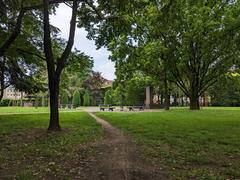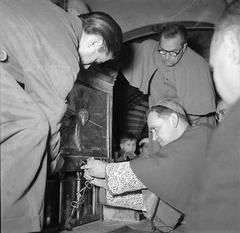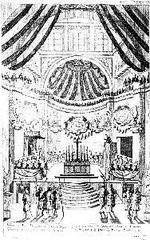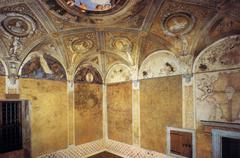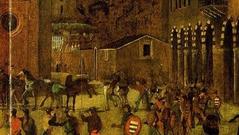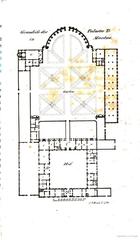
Torre della Gabbia Visiting Hours, Tickets, and Mantua Historical Sites Guide
Date: 04/07/2025
Introduction
In the heart of Mantua’s UNESCO-listed historic center, the Torre della Gabbia—literally, the “Tower of the Cage”—stands as a dramatic symbol of civic power, medieval justice, and architectural evolution. Erected in the late 13th century, this striking tower is inseparable from Mantua’s urban identity. Its iron cage, affixed to the façade since the 16th century, remains an emblem of the city’s complex history, serving both as a deterrent and a tangible reminder of the era’s harsh penal practices. Today, Torre della Gabbia is an essential destination for history lovers, architecture enthusiasts, and anyone eager to immerse themselves in the layered past of northern Italy.
This guide covers Torre della Gabbia’s history and cultural legacy, practical visitor information—including ticketing, accessibility, and visiting hours—and provides tips for exploring Mantua’s other historical treasures. All information is drawn from official and reputable sources, with links provided throughout for further research and planning.
For the most current updates, refer to the Mantua Tourism Official Website, Museionline, and Atlas Obscura.
Table of Contents
- Introduction
- Historical Overview
- Architectural and Artistic Features
- Practical Visitor Information
- Nearby Attractions & Suggested Itineraries
- Visitor Tips & Photography
- Frequently Asked Questions (FAQ)
- Visuals and Media
- References
Historical Overview
Medieval Origins and Ownership
The Torre della Gabbia’s origins trace back to 1281, when it was commissioned by the influential Acerbi family (Wikipedia). Its construction, possibly completed as late as 1302, reflects the defensive and symbolic needs of Mantua’s feudal elite (Museionline). The tower soon passed into the hands of the Bonacolsi family, who dominated Mantua until their ousting by the rising Gonzaga dynasty in 1328 (Travel Connect Experience).
The Gonzaga Era and the Iron Cage
The Gonzagas, whose rule transformed Mantua into a Renaissance capital, left an indelible mark on the tower. In 1576, Duke Guglielmo Gonzaga ordered the installation of a large iron cage—measuring roughly two meters by one—intended for the public humiliation and punishment of criminals (Atlas Obscura). This cage was used to display offenders, subjecting them to both the elements and the scrutiny of passersby. Notoriously, a Dominican friar was executed here in 1500 for a combination of criminal and sacrilegious acts (Live the World).
The cage, intended as a deterrent, became a symbol of the city’s justice system—its presence a stark reminder to all of the consequences of transgression (Museionline).
From Punishment to Preservation
Over time, changing attitudes toward justice and public punishment led to a reevaluation of the cage’s role. During Napoleonic reforms in 1798, local authorities decreed the cage’s removal as a repudiation of tyrannical practices—yet it was never taken down, and today it remains a unique historical artifact (Atlas Obscura). The tower itself passed through the hands of Mantua’s noble families, eventually coming under municipal care and, more recently, undergoing restoration following the 2012 earthquake (Mantua Restoration Project).
Architectural and Artistic Features
The Torre della Gabbia is a quintessential example of Lombard medieval architecture, later embellished with Renaissance details. Its brick construction and imposing height (approximately 55 meters) made it both a defensive stronghold and a symbol of wealth (Travel Connect Experience). The Renaissance-era façade, facing Via Cavour, features elegant marble pilasters and decorative motifs inspired by Andrea Mantegna’s school (Museionline).
Internally, the Bonacolsi family chapel is adorned with a rare 14th-century fresco cycle in the Giottesque style, offering a window into the religious and artistic life of the time (Museionline). The iron cage itself, mounted about a third of the way up the tower, remains the structure’s most distinctive and photogenic feature (Atlas Obscura).
Practical Visitor Information
Location
Torre della Gabbia is located at Via Cavour 102, just steps from Piazza Sordello—the heart of Mantua’s old town (Lonely Planet). Its central position makes it easy to include in any walking tour of Mantua.
Opening Hours & Tickets
- Exterior Viewing: The tower can be admired from the street at all times, as it sits in a public space.
- Interior Access: The interior is generally closed, but may open for guided tours or special events—check current visiting hours with the Mantua Tourism Official Website or local visitor centers (Museionline).
- Tickets: No ticket is required to view the exterior. Interior access, when offered, is usually part of a guided tour or event, with affordable pricing. Combination tickets with other sites (such as Palazzo Ducale or Palazzo Acerbi) may be available.
- Guided Tours: Walking tours of Mantua’s historic center often feature Torre della Gabbia. These tours provide valuable historical context and, occasionally, access to the tower’s interior.
Accessibility
Due to its medieval structure and private property access, the tower’s interior is not wheelchair accessible. The exterior, however, is accessible from the street. Contact local tourism offices for up-to-date accessibility details (Voce di Mantova).
Guided Tours & Events
Special cultural events, historical reenactments, and exhibitions may feature Torre della Gabbia—especially during Mantua’s festival seasons. For current schedules, consult the official tourism site or cultural event calendars.
Nearby Attractions & Suggested Itineraries
Torre della Gabbia’s central location makes it an ideal starting point for exploring Mantua’s key sites:
- Piazza Sordello: The main civic square, surrounded by historic palaces and the cathedral (Travel Connect Experience).
- Palazzo Ducale: A sprawling palace complex with gardens, art, and the famed Camera degli Sposi (JustInPlusLauren).
- Basilica di Sant’Andrea: A Renaissance masterpiece and pilgrimage church (Live the World).
- Rotonda di San Lorenzo: Mantua’s oldest church, dating to the 11th century (Live the World).
A typical itinerary might include a morning walk through Piazza Sordello, a visit to the nearby Torre della Gabbia, followed by a tour of the Palazzo Ducale and Mantua’s renowned churches. Don’t miss sampling local cuisine such as tortelli di zucca (The Travel Folk).
Visitor Tips & Photography
- Best Time to Visit: Early morning or late afternoon for soft light and fewer crowds.
- Photography: The iron cage and tower make for dramatic images; vantage points from Via Cavour and adjacent streets are ideal.
- Events: Check local calendars for special openings, guided walks, or exhibitions featuring the tower.
Frequently Asked Questions (FAQ)
Q: What are the Torre della Gabbia visiting hours?
A: The exterior is accessible at all times; interior visits are limited and scheduled for special tours or events. Always check current schedules before visiting.
Q: Is there a ticket required?
A: No ticket is needed for exterior viewing. Interior access, when available, may require a ticket or be included in a guided tour.
Q: Is the tower wheelchair accessible?
A: The exterior is accessible; the interior and cage are not due to medieval staircases and restricted access.
Q: Are guided tours offered?
A: Yes, many Mantua walking tours include the tower. Special guided access to the interior is occasionally available.
Q: Can I take photos?
A: Photography is permitted from the street. Interior photography may be restricted during tours.
Visuals and Media
- Image: Exterior view of Torre della Gabbia and iron cage (alt text: “Torre della Gabbia in Mantua with its iconic iron cage against the sky.“)
- Image: Bonacolsi chapel frescoes (alt text: “Bonacolsi chapel medieval frescoes Mantua.“)
- Map: Google Maps - Torre della Gabbia (replace xyz with the actual location).
References
- Mantua Tourism Official Website
- Mantua Historical Society
- My Kind of Italy
- Mantua Restoration Project
- Visit Italy
- Wikipedia
- Museionline
- Atlas Obscura
- Live the World
- Travel Connect Experience
- Lonely Planet
- Voce di Mantova
- JustInPlusLauren
- The Travel Folk
Stay Updated and Plan Your Visit
For more Mantua travel inspiration, see:


